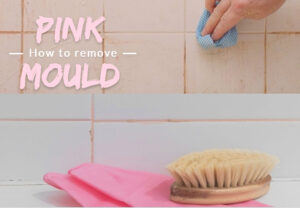
Pink mould often occurs in showers and tubs. If you have noticed such pink stains in your bathroom, that’s probably the case. Despite its name, pink mould is actually not mould at all. In fact, it is an overgrowth of a bacteria called Serratia marcescens. This is an airborne bacteria that thrives in damp, warm places. The colonies of this bacteria secrete a protein called prodigiosin and that is exactly what gives it its distinctive colour. Even though you may often see the pink residue in your bathroom, it is sometimes orange or even red.
The good news is that pink mould is not dangerous for your health, unlike black mould which can harm you in many ways. It is more of a cleaning issue and can only harm the good looks of your bathroom.
Pink mould can usually be found in bathrooms since humidity and warmth are its favourite things. Most often, it can be found in toilet bowls, at the bottom of the tub, shower, or on the walls surrounding them. If you think that humidity and warmth are enough for the pink mould, you are wrong. The bacteria actually require a diet of fats and minerals. Those can be found in residue from your soaps, bath products, mineral deposits, and body waste left behind.
As we mentioned above, pink mould is not dangerous and is in fact, rather easy to remove. Depending on the amount, it may take some time, patience and elbow grease, however, you should be able to get rid of it in no time. However, if you have black mould, it is best if you call a professional. You can usually find it on your walls, under sinks, or on floors. It is best that this is handled by experienced professionals for the best results.
Here is how to remove pink mould
- Mix a cleaning solution – Mix ½ cup of baking soda and 1 tablespoon of dishwashing liquid in a small bowl. You can use an all-purpose cleaner as well. The mixture will be runny. Make small batches and if you need more, just make some more.
- Wear protection – Even though pink mould is not dangerous, it is best if you wear rubber gloves, a mask or other protective gear. If you have open sores or cuts, make sure you protect them from exposure to bacteria as well.
- Remove the curtains and liner – Bacteria can grow on plastic and fabric, so it is best if you clean your curtain and liner as well. Even if you can’t see pink mould on their surface, wash them. Throw washable fabrics in the washing machine, and use hot water and your regular laundry detergent. Make sure you check the fabric care label and never put plastic curtains in the dryer. If your curtains are covered in mould, consider replacing them so that you maintain your bathroom healthy.
- Scrub bacteria away – Grab a nylon-bristled brush and dip it in the baking soda solution. Start at the top of the affected area and work your way down. The baking soda will act as a gentle abrasive and help loosen the mould.
- Rinse the area – Use a handheld shower head, or dip a clean cloth in plain water and use it instead. Make sure you remove all residue.
- Disinfect the area – Bacteria are not easy to kill. In order to properly remove it from the surface, it is best to use a disinfectant. Mix your own disinfecting solution by mixing a 1:1 solution of warm water and chlorine bleach.
- Spray and scrub – Spray the disinfecting solution all over the area you are cleaning. Let it sit for 10-15 minutes. That time will allow the disinfecting solution to kill all the bacteria. What is more, it will also remove any stains that can be found on the surface. Use a clean scrub brush and go over the whole area one more time.
- Rinse and dry the surface – Rinse the whole area using a handheld shower head or a bucket full of water. Make sure you remove all of the bleach solution. Use a squeegee to remove most of the moisture and dry the surface. Use a dry clean cloth to wipe the area down. This will prevent streaks and water spots.
- Hang your curtains back in place – Hang the freshly washed, dry curtains.
Extra tips to present pink mould growth:
- Regularly clean all your bathroom surfaces. That will prevent future mould growth.
- Wipe down your shower walls after every use. Keep a squeegee nearby and do not forget to dry your shower. Pink mould bacteria love moisture and in order to prevent future growth, you should keep your bathroom surfaces dry.
- Wash your shower curtains at least once a month. Close and straighten them to help them dry faster.
- Clean soap scum regularly. Do not allow it to build up since it contains body oils that serve as food for mould bacteria.
- Wipe away any spills of shampoos, soaps, etc. from your shower walls, and the inside of your tub.
- Regulate the humidity levels at home. Place a fan in your bathroom and keep your windows open when possible to improve airflow.